#Alchemical Philosophy
Text
Alchemical Marvels: Navigating the Secrets of Collectanea Chemica

Arthur Edward Waite's "Collectanea Chemica" is a captivating exploration into the enigmatic realms of alchemy and hermetic medicine, transcending time to unveil the mystical allure of ancient wisdom. With its rich tapestry of select treatises, this book beckons readers on a mesmerizing journey through the esoteric corridors of the alchemical tradition.
Waite, a distinguished scholar and esotericist, curates a collection that serves as a portal to the profound insights of alchemists and hermetic practitioners. The book’s pages are imbued with the mystique of the past, offering glimpses into the spiritual and transformative pursuits that have echoed through the ages.
The treatises within "Collectanea Chemica" serve as illuminated manuscripts of alchemical philosophy, each unfolding a unique facet of the practitioner's quest for enlightenment. From the Magnum Opus to the pursuit of the Philosopher's Stone, Waite guides readers through the labyrinthine corridors of alchemical thought, where base metals transform into gold, and the elixir of life beckons with promises of immortality.
Waite’s meticulous annotations and commentary provide a guiding light, illuminating the complex symbolism and allegorical language employed by alchemists. His insightful notes bridge the temporal gap, making the esoteric knowledge accessible to modern seekers of wisdom.
The title itself, "Collectanea Chemica," resonates like an incantation, conjuring the very essence of ancient laboratories and the alchemist's pursuit of the arcane. It beckons readers to delve into the alchemical opus, enticing them with promises of arcane knowledge and the potential for profound transformation.
In essence, "Collectanea Chemica" is not merely a book but a transcendental guide—an alchemical roadmap inviting intrepid minds to decipher the secrets of hermetic wisdom. Arthur Edward Waite, with his scholarly finesse, ensures that the alchemical fire within these pages continues to burn, casting its luminous glow on those who dare to embark on this intellectual and spiritual odyssey.
Arthur Edward Waite's "Collectanea Chemica" is available in Amazon in paperback 11.99$ and hardcover 18.99$ editions.
Number of pages: 138
Language: English
Rating: 9/10
Link of the book!
Review By: King's Cat
#Alchemy#Hermetic Medicine#Arthur Edward Waite#Magnum Opus#Philosopher's Stone#Esoteric Wisdom#Mystical Tradition#Alchemical Treatises#Spiritual Transformation#Occult Knowledge#Elixir of Life#Transmutation#Symbolism#Ancient Wisdom#Illuminated Manuscripts#Hermeticism#Alchemical Philosophy#Secret Knowledge#Metaphysical Exploration#Alchemical Symbolism#Spiritual Alchemy#Mystical Illumination#Philosophical Gold#Transcendental Insights#Occult Tradition#Esoteric Manuscripts#Alchemical Secrets#Symbolic Language#Immortality Quest
3 notes
·
View notes
Text
Alchemical Marvels: Navigating the Secrets of Collectanea Chemica

Arthur Edward Waite's "Collectanea Chemica" is a captivating exploration into the enigmatic realms of alchemy and hermetic medicine, transcending time to unveil the mystical allure of ancient wisdom. With its rich tapestry of select treatises, this book beckons readers on a mesmerizing journey through the esoteric corridors of the alchemical tradition.
Waite, a distinguished scholar and esotericist, curates a collection that serves as a portal to the profound insights of alchemists and hermetic practitioners. The book’s pages are imbued with the mystique of the past, offering glimpses into the spiritual and transformative pursuits that have echoed through the ages.
The treatises within "Collectanea Chemica" serve as illuminated manuscripts of alchemical philosophy, each unfolding a unique facet of the practitioner's quest for enlightenment. From the Magnum Opus to the pursuit of the Philosopher's Stone, Waite guides readers through the labyrinthine corridors of alchemical thought, where base metals transform into gold, and the elixir of life beckons with promises of immortality.
Waite’s meticulous annotations and commentary provide a guiding light, illuminating the complex symbolism and allegorical language employed by alchemists. His insightful notes bridge the temporal gap, making the esoteric knowledge accessible to modern seekers of wisdom.
The title itself, "Collectanea Chemica," resonates like an incantation, conjuring the very essence of ancient laboratories and the alchemist's pursuit of the arcane. It beckons readers to delve into the alchemical opus, enticing them with promises of arcane knowledge and the potential for profound transformation.
In essence, "Collectanea Chemica" is not merely a book but a transcendental guide—an alchemical roadmap inviting intrepid minds to decipher the secrets of hermetic wisdom. Arthur Edward Waite, with his scholarly finesse, ensures that the alchemical fire within these pages continues to burn, casting its luminous glow on those who dare to embark on this intellectual and spiritual odyssey.
Arthur Edward Waite's "Collectanea Chemica" is available in Amazon in paperback 11.99$ and hardcover 18.99$ editions.
Number of pages: 138
Language: English
Rating: 9/10
Link of the book!
Review By: King's Cat
#Alchemy#Hermetic Medicine#Arthur Edward Waite#Magnum Opus#Philosopher's Stone#Esoteric Wisdom#Mystical Tradition#Alchemical Treatises#Spiritual Transformation#Occult Knowledge#Elixir of Life#Transmutation#Symbolism#Ancient Wisdom#Illuminated Manuscripts#Hermeticism#Alchemical Philosophy#Secret Knowledge#Metaphysical Exploration#Alchemical Symbolism#Spiritual Alchemy#Mystical Illumination#Philosophical Gold#Transcendental Insights#Occult Tradition#Esoteric Manuscripts#Alchemical Secrets#Symbolic Language#Immortality Quest
2 notes
·
View notes
Text
okay
let's talk about alchemical readings and rwby.
as the resident crank it would be remiss of me not to begin this little jaunt with a very important disclaimer: like all esoteric lenses, alchemical philosophy is an analytical framework that relies quite heavily on symbolism, and because of that it is really important to be mindful of how you're engaging with the text. symbolism services narrative, not the other way around, and you should always let the narrative guide your understanding of its symbolism. if that doesn't make sense to you, don't worry, because there will be lots of examples to illustrate what i mean.
before getting into the weeds, we're going to lay out some basic alchemical concepts.
in simple terms, the core philosophical idea of alchemy is a gradual process of transformation from base material into the sublime; conceptually the transmutation of lead into gold is also the perfection of human body and soul. alchemy is about change, refinement, rebirth, wholeness.
the prima materia—first matter—is the perfect and formless primordial matter of which all forms of matter are derived. if you're familiar with certain other alchemical readings of rwby you'll have seen it defined as the "raw material" that is transformed into the philosopher's stone through the alchemical process; that is not inaccurate but it must be stressed that the idea here is that ordinary matter comes from the prima materia and the philosopher's stone IS the prima materia, made perfect and whole again through the great work.
<- rwby directly invokes this idea in 'all things must die' ("all bonds dissolve/infinite matter/will always evolve").
yliaster is another name (coined by paracelsus) for the prima materia, which he described as "completely healed human being who has burned away all the dross of his lower being and is free to fly as the phoenix."
the great work is the actual process of alchemy. it is classically broken down into four (or three) stages, each represented by a color:
nigredo, black, involves putrefaction and charring—symbolically, death. decay. rot.
albedo, white, involves purification and separation. the undifferentiated mass of the nigredo stage is clarified and divided into two opposing principles.
citrinitas, yellow, is the "dawn" or reawakening.
rubedo, red, involves coagulation and recombination after the separation undergone in albedo.
citrinitas is not always treated as a discrete stage, instead sometimes being combined into a single stage with rubedo or understood as the transition between albedo and rubedo. hence "four (or three)." there are also a great variety of other stages, mostly given in sets of seven or twelve and listed in myriad sequences, but for our purpose this four-or three-stage model is the most useful.
now!
ordinarily with an alchemical reading, we would begin by finding a narrative pattern of symbolic death and rebirth, but for rwby we first need to interrogate the goliath in the room, namely:
YES, IT'S ABOUT SALEM.
there is a tendency in alchemical readings of rwby to interpret salem's immortality as a lifeless unchanging stasis, and thus to read her as an embodiment of the anti-theme, and surprising absolutely no one i find this to be… well, just not right at all.
rwby initially sets up the pattern through the mantra pyrrha recites when she awakens jaune's aura: "for it is in passing that we achieve immortality. through this we become a paragon of virtue and glory to rise above all, infinite in distance and unbound by death. i release your soul, and by my shoulder protect thee." 'rising' explicitly calls back to this ("we are paragons of virtue and glory/death can't bind our endless story/infinite and unbound") and 'indomitable' reiterates the idea ("when we strive, we transcend/even death cannot end our climb"); this is important to note because the repetition correlates with revelations about salem's story.
the key thing to understand here is that 'the lost fable' is narratively structured around salem's deaths:
first, the god of light bites her and she's drowned in the fountain of life (notice her last breath leaving her mouth; she chokes for air and her eyes rolls back as she loses consciousness, sinking into the depths)…



…and then the god of darkness brings the moon down on her head and she wanders in a haze until finding her way back to the pool of grimm, where she seeks her own destruction and is created anew.

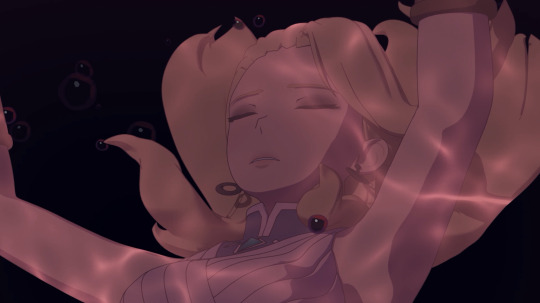

the brothers cast salem into the fountain of life, which pools under the roots of a tree and appears to be infinitely deep. she drowns as she sinks into its darkness—then abruptly reawakens hitting the water again, now only a reflecting pool, and the water-light of aura shimmers over her hands as she rises.
"for it is in passing that we achieve immortality…" the reprisal of "infinite and unbound" in 'rising' draws a line from pyrrha's mantra to the lost fable for a reason; it's to help us understand the truth behind the story jinn is telling. it is not even subtext—it is text. especially after volume nine, which clarifies the symbolic meaning of the tree growing above the waters.
through death, salem became immortal—infinite—and the infinite waters of life and creation became finite.
that water was the prima materia of the brothers' world; it combined with salem—the prima materia changes itself and combined with all imperfect bodies that it touches—and thus she herself became yliaster, "the perfectly healed human being who has burned away all the dross of his lower being and is free to fly as the phoenix."
the dross in her case being the brothers and their divine order, she rebels against them, and they destroy their world. she is all that remains. they leave salem behind in the end of all things and, phoenix-like, she rises out of the ashes of her destruction. yliaster is the prima materia; it contains everything, is everything, and everything is released when it is broken apart.
"this force of pure destruction could not destroy a being of infinite life, so it created a being of infinite life with a desire for pure destruction." destruction exists within creation exists within destruction: salem embraces death, throwing herself into the "blackened pools of annihilation" in the land of darkness. nigredo.
she's torn apart and reborn, and remnant is born with her, a pure-white being clambering into a revitalized new world she cannot touch; after a long separation, her partner returns to her and she experiences love, connection, freedom for the first time in years, until she learns that he seeks the destruction of this world and a return to the old and they burn each other alive in a violent parting. albedo.
salem's arrival in atlas literally at dawn incites the struggle between herself and cinder, which culminates in salem beginning to relinquish control and as her true feelings come to the surface. citrinitas.
thus, what remains of her story is rubedo: reconciliation with cinder, reunion with ozma, peace between humans and grimm (<- unity of opposites), and finally symbolic transcendence over death by convincing the god of light to ascend, with "death" being specifically the threat of annihilation represented by the divine mandate.
ozma's arc, of course, mirrors hers very closely: the god of light breaks him apart, the god of darkness burns him (nigredo)—his reincarnation divides him very literally into two, and symbolically divides him between duty and desire (albedo)—he awakens with the dawn, reconciles with oscar, and begins to face the truth in atlas (citrinitas).
as alchemical readings go, this one is not difficult or arcane or remotely ambiguous. it isn't even symbolic; the deaths and resurrection are explicitly literal and occur onscreen with the accompaniment of helpful explanatory notes. the goliath in the room is making aggressive eye contact.
but we are not done here yet, because i never do anything by halves and we have symbolism to talk about.
THE GREAT WORK.
salem, you will recall, is yliaster, the prima materia of remnant. you will also recall that the prima materia is the formless primordial matter from which all other matter is formed, and thus it is both the raw material of the great work and the philosopher's stone. yes? good. rwby interrogates this contradiction through the idea of balance, which the god of light conceives of as an inviolate order that must be designed and enforced. but, as the blacksmith explains, his understanding is a limited falsehood:
"balance is not two forces locked in never-ending battle. balance is an ecosystem, an organism, a living, breathing thing; thus balance cannot be restored by force or calculation. it only requires love and the patience to see things through to the end."
here is where i think a lot of the fandom—not people doing alchemical readings necessarily, but in general—miss the mark by interpreting this to mean that opposition and balance are antithetical to each other, that a system with two opposing forces is inherently out of balance. rwby's metaphysics are grounded in hellenistic philosophy, plato in particular (<- neoplatonism had a significant influence on the western european alchemical tradition), and the philosophical ideas undergirding the ever after follows herclitus.
(i recommend perusing the category pages for λόγος, justice and strife, the harmony of opposites, φύσις, ψυχή, cosmology, fire, water/the river, life/death, and waking/sleeping—i know that sounds like a lot of reading, but it isn't, as what we have of heraclitus is only fragments and the summaries provided are brief and accessible.)
the two key ideas we're interested in here are flux and strife. the world exists at rest in a continual state of change; a river is always the same river, but its flowing waters change from moment to moment. this conception of the world—"changing, it rests"—is flux. strife incites change through the tension between opposing forces. strife is not discordant but rather harmonious: "men do not know how what is at variance agrees with itself. it is an attunement of opposite tensions, like that of the bow and the lyre." (B51) just as a bow could not fire and a lyre could not sing without tension on the strings, so the world could not be without strife.
this is what the blacksmith means by balance. true balance is not war; it is strife. not two forces locked in never-ending conflict, but opposite tensions in harmony with each other. destruction and creation are opposing forces, but each exists within the other and they are both interdependent and inseparable.
salem embodies this theme. through death, she became life, and by destruction she was created. human and grimm, light and darkness, creation and destruction. she seeks to tear down the huntsmen academies and incite revolution in pursuit of a new world. she is balance—and the god of light inflicted his punishment upon her not because she failed to understand the importance of life and death, but because her dedication to change challenged his false and hollow conception of what balance means.
this guides the alchemical reading of the wider narrative in significant ways. salem is the prima materia of remnant—yliaster, broken apart to release everything contained within—and thus both the subject and the aspiration of the great work. when we examine other characters through this lens, it is in relation to her.
we'll begin by discussing the narrative's big symbols: the rose, the broken moon, the tree, grimm, silver eyes, and fire.
traditionally, the rose symbolizes rubedo. in most alchemical readings of rwby, ruby rose is accordingly presumed to represent this stage for obvious reasons—however, if we pay attention to how the narrative itself symbolically identifies the rose:
ruby's emblem, which she inherited from her mother, is a burning rose.
our first sighting of it is on summer rose's grave, above an epitaph—"thus kindly i scatter"—taken from a poem which uses the death of a rose as a metaphor for the speaker's loneliness and despair.
"red like roses fills my dreams and brings me to the place you rest," and "red like roses fills my head with dreams and finds me always closer to the emptiness and sadness that has come to take the place of you"
adam's emblem is a withered rose.
"the moon will sadly watch the roses die"
"maybe red's like roses? maybe it's the pool of blood the innocents will lay in when in the end you fail to save them"
"the rose will grow to be a seed, from every life another leads" (<- evokes an image of deterioration, rot; the rose going to seed)
"some roses will never bloom, some dreams will rot on the vine"
in rwby, the rose represents death. it burns, it withers, it dies, it is scattered, it never blooms; thus, it does not symbolize rubedo but rather the death and decomposition of nigredo. why then is ruby's primary color red? we'll get to that in a little while.
the moon traditionally symbolizes albedo, which is a process of separation, reflection, and illumination. the god of darkness shattered the moon as he departed after slaughtering humanity, and:
"the moon will sadly watch the roses die"
"the sky is turning black, light is fading fast, but we don't surrender; shattering the night, radiant and bright, armored in splendor, shining forever […] we're rising like the moon"
salem falls into and through the reflection of the broken moon when she casts herself into the pool of grimm
the broken moon symbolizes the death and resurrection of humankind, which—as noted—is the beginning of the albedo stage in salem's story.
so in rwby the broken moon does indeed represent albedo.
the tree, obviously, represents the whole circle of life-death-rebirth, with its symbolic meaning on remnant following its actual function in the ever after, where it is the cosmic tree, the river, and the ever-living fire. thus cinder and salem falling into pools of water at the base of a tree are symbolic (and in salem's case, also literal) rebirths.
grimm are "manifestations of anonymity," "the darkness," hates and feared as soulless monsters, destruction incarnate, thought to have no purpose other than to exist as "mankind's greatest foe." rwby is consistent in using the grimm to symbolize ostracism, persecution, fear of the other or the unknown, and salem's exile is justified (in ozma's mind) by her grimmness. which is to say, the grimm represent the separation undergone during albedo; they are the darkness to humanity's light. (hence, the narrative building toward coexistence between humans and grimm, exemplified by the faunus.)
silver eyes are described in opposition to the grimm and likewise represent the separation of albedo; the light to grimmkind's darkness. salem's experimentation with combining them into one being is a faunus for good reason, and i do not think it is coincidental that cinder has become less vulnerable to the glare as she finds balance with the grimm arm. and speaking of her:
the phoenix is another traditional symbol for rubedo, which naturally calls to mind associations with fire. citrinitas, similarly, is represented by the dawn or the "solar light," overtaking the moonlight of albedo, which again connotes fire. in rwby, fire is used to symbolize hope and wrath, which are thematically intertwined (hope ignites fire -> loss of hope incites wrath -> wrath ignites fire, and is thus a form of hope):
"even the smallest spark of hope is enough to ignite change […] nature's wrath in hand, man lit their way through the darkness"
"a simple spark can ignite hope, breathe fire into the hearts of the weary…" becoming "i can't wait to watch you burn"—salem seeks to smother ozma's hope, and thus rekindle her own.
"the light of hope is taken and discontent is the contagion; the blinding eyes that burn a yellow flame, the embers that remain will light the fuse of condemnation"
"we were destined to light the flame of revolution; consider this the spark" + "i think father may have just provided the spark that's going to set this kingdom on fire"
flame imagery used in relation to cinder and salem in the volume eight opening and jaune throughout volume nine.
cinder being… a spark…
as i noted, the paradigm shift between salem and cinder in atlas represents the transition from albedo to rubedo through the dawn. in rwby, the kindling spark symbolizes citrinitas and the changing flame that follows is rubedo. the role cinder will play in reigniting salem's hope is obvious, and the symbolic use of fire to reawaken first jaune and then neo in volume nine only underscores this meaning. in combination with the dust and ashes motif going on with salem and the grimm, the fire becomes specifically phoenix imagery.
now!
why, if the rose is nigredo, is ruby red?
in order to explain this, we first need to examine team STRQ, because the answer is that the great work is cyclical.
in team STRQ, we have:
summer rose, whose red-and-gold interior is masked by her white exterior
taiyang xiao long, who is all yellow
raven branwen, who is an amalgam of red and black
qrow branwen, who is mostly white except for his red cape
the branwen twins also transform into corvids, traditional symbols for the nigredo stage; qrow's scythe harbinger and raven's allusions to the morrígan underscore their symbolic association with death.
if we consider these color associations through an alchemical lens, the pattern that emerges is—by design—muddled and strange, but not actually that convoluted:
raven "tried to leave," but couldn't. she became the spring maiden by mercy-killing a girl whom she loved as her own family, and never having dealt with that grief or guilt, is trapped in nigredo whilst projecting a hollow image of rubedo—her pretense of strength. she runs away from her feelings, rather than challenging or examining them; what she needs instead is to separate and reflect honestly on herself.
summer did leave. her white outer shell—the phantom she left behind—suggests albedo, but her true colors are what she wears beneath the cloak: red trimmed with gold. she found salem, listened to her and awoke to the truth of this world, and then joined her. but in order to do that, she had to separate from her own family, joining salem exile; thus her individual rubedo brings her into alignment with the grimm in salem's albedo.
qrow, shattered by the dissolution of his team, is undergoing his own albedo. like his sister, he wears the trappings of rubedo—he is the one left standing, ozpin's most trusted agent—but this is a false projection which crumbles once it challenged by the revelations of ozma's deceit. his drinking and reluctance to be around people for fear of bringing them to harm make it impossible for him to move forward until he finds new hope and decides to try again. like his onetime mentor, he experiences citrinitas in atlas and the beginning of his transition into rubedo is marked by the introduction of maroon (desaturated red) and tan (desaturated yellow) into his atlas fit.
tai, lastly, is interesting because in one sense, he is citrinitas in isolation, a dawn with nothing to illuminate because his team left him behind, but in another sense, tai mediates the generational transition between team STRQ (albedo) and team RWBY (rubedo). he is yang and ruby's father and—crucially—he raises both in idealized casts of their mothers. ruby feels compelled to live up to the fairytale idea of summer rose; tai tells yang that he sees all of raven's good qualities in her and warns her to be wary of being too much like her mother, in almost the same breath.
ruby's red and yang's yellow represent the culmination of what tai wishes could have been; the summer rose who returned whole and alive, the raven branwen who chose reflection and reawakening instead of running away. but both colors are only things projected onto them—false images.
in truth, ruby represents nigredo. her scythe and the burning rose both connect her to death; her semblance disassembles her into a swirling formless mass of rose petals; her own identity is lost beneath the idea of summer rose and the first nine volumes of the story are devoted to the long, slow journey to her symbolic death at the roots of the tree.
only with her ascension has she begun to undergo albedo (notice the greater emphasis on her silver eyes and the flaring white light as she comes out of the tree; also, "otherside, did you mean to leave me half or whole? will i ever be complete? when will i become all of me?" and "what is left? i know it's you and i when i look inside"—she is beginning to separate herself from the imaginary paragon.
weiss represents albedo—her story is fundamentally about separation from her family, leading to self-reflection and growth, and in the process she has become an emotionally intelligent, insightful person who consistently helps others draw out and clarify their hidden emotions. her mirror motif and her knight summon further represent this: the self and the reflection.
blake represents citrinitas—her golden eyes, her association with the black king, her identity as a faunus, all support this reading. her time with the white fang was her albedo (she lost herself, gradually began to see herself in a new light, and finally separated herself from everything adam represented) and her personal moment of citrinitas is the removal of the bow and meeting with sun after she reveals herself as a faunus, after which she begins her journey of rediscovering herself and reintegrating with her faunus heritage.
finally, yang represents rubedo—her fire, her red eyes, "scathing eyes ask that we be symmetrical, one-sided and easily processed, yet every misshapen spark's unseen beauty is greater than its would-be judgment," "feel like i'm finally unbroken, feel like i'm back from the dead," the whole thematic conceit of bumbleby being the catalyst and the flame, the dawn and the sun, and so forth, two-in-one, "we're protecting each other."
the team collectively represents rubedo in relation to salem, in that they will be the ones primarily negotiating with her and this will obviously not begin to happen until ruby has her personal moment of citrinitas, which is to say not until ruby meets the real summer rose.
as a final point of interest, the four qualities (and relics) of destruction, creation, knowledge, choice map neatly onto the four-or-three alchemical stages—destruction as nigredo, creation as albedo, knowledge-then-choice as citrinitas-then-rubedo—and given the parallelism between yang and cinder, blake and raven, and weiss and penny+winter, it is probably a safe bet that the summer maiden is a) not summer rose, and b) a character foil to ruby, which i think adds some weight to the gillian theory.
anyways.
the philosopher's stone is ozlem.
#to be clear i think the alchemy thing is more convergent evolution from plato than deliberate use of alchemical structure#but neoplatonism did significantly influence western european alchemical philosophy so there is a lot to work with#and putting it in alchemical terms can be a clarifying analytical shorthand#as long as you don't. ignore everything the narrative spells out wrt salem#ANYWAY. HERE. TAKE IT.
30 notes
·
View notes
Text
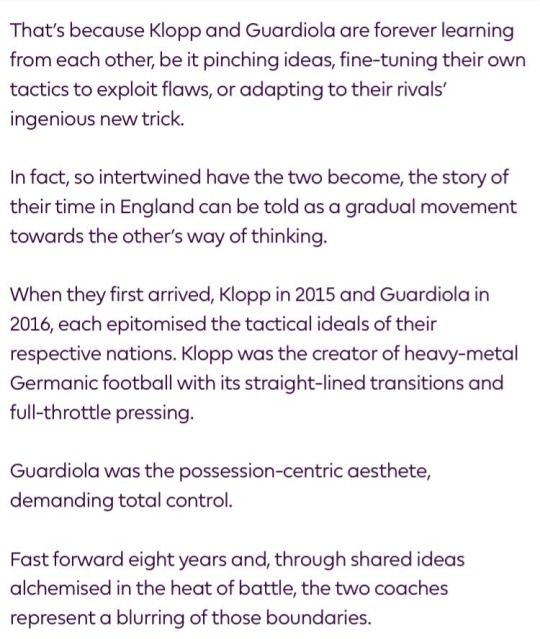
this is kind of peak romance idrc what anyone says
#'so intertwined have the two become'#fellas is it gay to change and adapt ur own philosophy because of another man#TOWARD the philosophy of that man#two old men are friends#also 'alchemized in the heat of battle' lol interesting phrase
16 notes
·
View notes
Text
The Philosophers of Fire
One of the central concepts in alchemy was the idea of the four elements: earth, air, water, and fire, which were believed to be the basic constituents of all matter.
Among the alchemists, there were those who specialized in the element of fire, and they were known as the philosophers of fire. These alchemists believed that fire was the primary agent of change and transformation, and that it had…

View On WordPress
#alchemical symbolism#alchemist#alchemists#alchemy#fire#I was born in the fire#philosophers#philosophy#phoenix#purification#spirituality#sulfur#symbolism#the phoenix#transformation#zosimos#zosimos of panopolis
6 notes
·
View notes
Text
Allen G. Debus. The English Paracelsians. London: Oldbourne Book Co. Ltd, 1965. Hardcover. 222 pages.
Shop link in bio.
instagram
#alchemist#alchemists#alchemy#alchemical#paracelcus#early modern period#english history#history of science#esotericism#occult philosophy#history of medicine#chemistry#bookseller#booksellers#Instagram
2 notes
·
View notes
Text
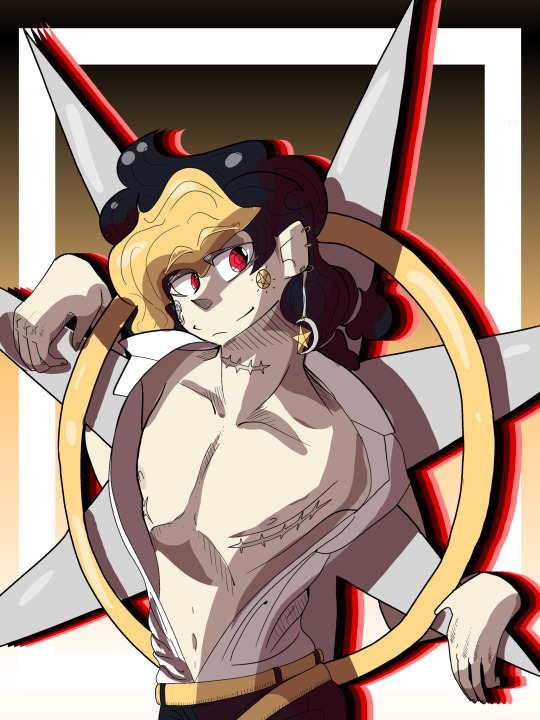
The Azoth is the completion of the three hermetic cores in sequence with the seven stages of alchemy. It is not the Alkahest, but the process to obtain it: stemming from metaphysical lead to gold. In Hermeticism, to obtain heaven is seen as something only possible after death.
Chae-Seon, self-proclaimed Alkahest, believes that it can attain Heaven among mortals.
#my art#art#artists on tumblr#oc artist#ask me and i'll tell you#oc art#my ocs#alchemy#alchemy symbols#hermetic principles#hermetic philosophy#hermeticism#azoth#alchemical#villain#villain oc#alchemist oc#fantasy#fantasy oc#character art#character design#androgyneity#androgynism#androgynous#androgynous oc#androgynous character#transgender#trans character#trans oc#transando
1 note
·
View note
Text
Western alchemical texts often resembled mystical riddles. Now, we all love some mystical books of alchemical riddles, it’s half the fun of early alchemy, but Arabic alchemical works are written more like teaching materials. This is because they were often used as teaching materials. Where earlier alchemists needed to encode their works as a form of proto-copyright, Islamic alchemists were trying to efficiently collect and distribute information. Though be warned, “easier to read” by the standards of medieval alchemists is still pretty dense. Hope you like neoplatonism, because in terms of density, Islamic alchemy is a neoplatonic pound cake, with nuts. (The nuts are hermeticism in this metaphor.)
“But who cares?” I hear you ask “Isn’t this supposed to be a book about magic? Why are we talking about these dead Arab philosophers?” Remember, dear reader, that some of the first esotericists in western history were Plato and Aristotle, but their ideas didn’t mesh all that well.
Many a wizard-philosopher tried and failed to glue them together. Most failed. Some resorted to pretending to be Aristotle, publishing books under his name. For the Byzantines, the idea of reconciling Plato and Aristotle was almost laughable. The neoplatonists said they could do it, but few took them seriously.
By the time the Baghdad House of Wisdom, neoplatonism had time to mature. For the Muslims, it was damn near philosophy 101. The idea that Plato and Aristotle conflicted at all was laughable. “What do you mean Plato and Aristotle don’t fit together? Everyone knows they fit together.” And thus, one of the greatest roadblocks to early magic was smoothed over. The twin cities of early magic were separated by a river, the neoplatonists would cross it, and the Baghdad House of Wisdom would build a bridge.
Islamic Alchemy, today on da Patreon
1K notes
·
View notes
Text
The Alter of The Qabalistic Alchemist : The alter is dedicated and gives breath from the Great Wind to Glorify God first, then all of the Source’s creations. Gnosis , Love for Sophia (Wisdom) and Building of the Merkabah, Earth Wind Fire Water Spirit- the pentagram Mary Magdalen/Radharani/ Isis / Mother Mary / Venus: the divine feminine and divine masculine, the glory of the Alchemical Wedding, the Beauty of Nature and Colors of Nature, the miracle of Holy Water, the Hermetic sciences , Thoth, the Tarot, Alchemy , The alchemical miracle of tuning Lead into Gold, the Masonic wisdom of Squaring the Circle , using the philosophers stone and the sealing of Pandora’s Box. 🔯☸️☯️✝️☪️💟🕉
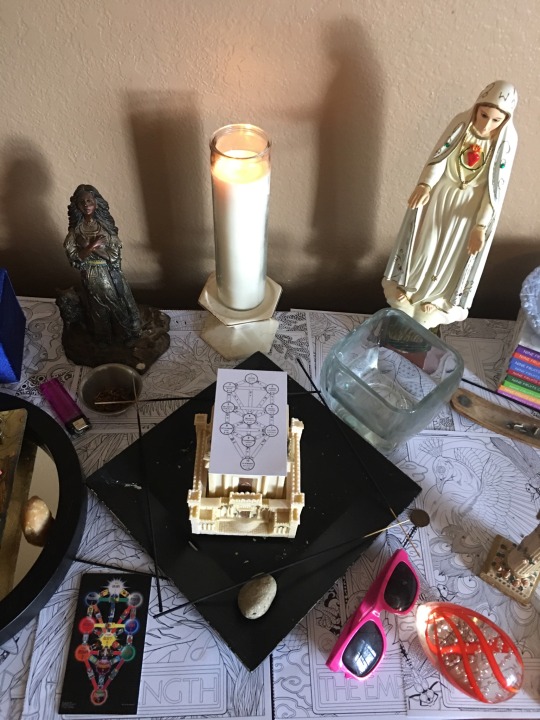

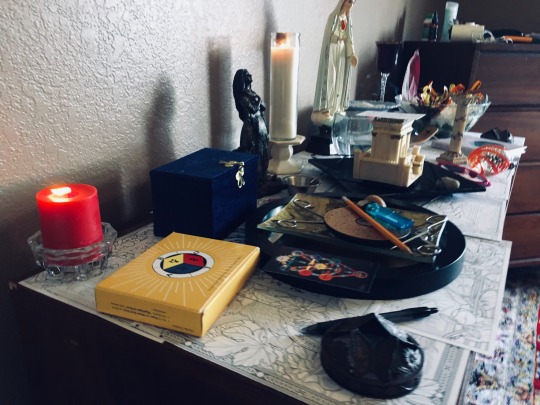


#the book of thoth#thoth#esoteric#blog post#gnosticism#occult#magick#writers on tumblr#divination#my altar#altar setup#altarspace#altar#merkaba#alchemicalbalance#alchemical water#gnostic teachings#philosophy#hermetic philosophy#mary magdalene#virgin mary#radharani#virgo venus#freemasonry#black cube#aquarius#flowerbowl
0 notes
Text

CONJUNCTION (Canvas, Bic)-the idea of bringing together opposites to achieve harmony and synthesis, representing a central theme in alchemical philosophy and symbolism.
119 notes
·
View notes
Text
astro notes: jupiter 🪐💫
Jupiter embodies a multifaceted symbolism that is deeply rooted in its associations with growth, expansion, wisdom, and spiritual evolution. Often linked with the metal tin and representing qualities of malleability and resistance to corrosion. This association suggests that Jupiter's influence encourages individuals to be adaptable and resilient in their spiritual journeys, while also remaining steadfast against negative influences.
Associated with the element of air, symbolizing intellect, expansion of consciousness, and the dissemination of knowledge. Air is seen as a purifying element, really suggesting that Jupiter's influence can help clear mental obstacles and facilitate the growth of higher understanding.
Esoterically, Jupiter is seen as a planet of trust, faith, growth, and expansion. It symbolizes adventure and hope, inspiring individuals to embrace new experiences and opportunities for personal and spiritual growth. Jupiter's association with the etheric heart center highlights its role in connecting the individual with the cosmic sphere. It fosters a sense of unity with the universe, allowing human actions to be instilled into the essence of the images of the cosmos. This suggests that Jupiter's influence transcends individuality, contributing to the unfolding and metamorphosis of forms at the heart of evolution.
In Sagittarius, Jupiter's influence is amplified, as this sign resonates deeply with Jupiter's qualities of expansion, growth, and spiritual questing. Sagittarius is associated with the element of fire, representing inspiration, enthusiasm, and the spark of divine creativity. This fiery nature aligns with Jupiter's alchemical association with the metal tin, suggesting a transformative and dynamic energy that propels individuals towards higher understanding and enlightenment.
Sagittarius is also linked to the ninth house in astrology, which is traditionally associated with higher learning, philosophy, and travel. This connection further emphasizes Jupiter's role in broadening one's horizons through intellectual exploration and spiritual expansion. Individuals with strong Sagittarian or Jupiterian influences in their charts are often drawn to philosophical and spiritual pursuits, seeking to understand the deeper meaning of life and their place in the universe.
In Pisces, Jupiter's energy takes on a more mystical and transcendent quality. Pisces is a water sign, symbolizing the depths of the unconscious mind, intuition, and spiritual sensitivity. This watery nature aligns with Jupiter's alchemical association with the process of projection, suggesting a deep-seated urge to merge with the divine and project one's inner transformation onto the world.
Pisces is associated with the twelfth house in astrology, which is traditionally linked to spirituality, introspection, and hidden knowledge. This connection further emphasizes Jupiter's role in guiding individuals towards spiritual enlightenment and self-discovery. People with strong Piscean or Jupiterian influences in their charts are often highly intuitive and empathetic, with a deep understanding of the interconnectedness of all beings.
follow for more astro insights like this and support me over on yt @quenysefields or instagram sensualnoiree
#jupiter#astrologer#astrology readings#astrology signs#astro#astrology#astro blog#astro community#astro notes#astro observations#astro placements#astro posts#astroblr#astrology chart#astrology fyp#astrology notes#astrology observations#astronotes#astro stuff#astrology stuff#pisces#sagiittarius#spirituality#mpls#gemini#aries#taurus#cancer#leo#virgo
138 notes
·
View notes
Text
"Unlocking the Esoteric Tapestry: A Journey Through 'The Alchemical Writings of Edward Kelly'"

"The Alchemical Writings of Edward Kelly" invites readers into the mystical realm of alchemy through the eyes and pen of the enigmatic Edward Kelly, a figure deeply intertwined with the alchemical pursuits of the Renaissance. This collection, skillfully compiled and annotated, unveils the arcane wisdom and esoteric insights of a man whose contributions to the Hermetic arts have long been shrouded in mystery.
Kelly's writings, presented with meticulous attention to historical context, offer a profound glimpse into the spiritual and transformative aspects of alchemy. The editor's annotations guide readers through the labyrinth of alchemical symbolism, providing clarity without diminishing the mystique. From the famed Enochian system to the allegorical language of transmutation, Kelly's words resonate with seekers of hidden truths.
The anthology captures Kelly's alchemical opus, showcasing the intricacies of his experiments, the symbolism embedded in his writings, and the quest for spiritual enlightenment. It serves as a key to decoding the cryptic language of alchemy, making it accessible to both seasoned practitioners and curious minds.

(The illustration presented in the book: a black rock, on which stand, hand in hand, the planets: 1, Black Saturn, falling down; 2, Jupiter; 3, Mars; 4, Mercury of many colours; 5, Venus, with green robe, and the Sun and Moon. Lower down, on the black rock, stands an old man with a pick-axe, cutting a piece out of the rock, whence Saturn falls, and near him lie, as if dead, Jupiter and Saturn.)
As the pages unfold, readers are immersed in the alchemical laboratory of Kelly's mind. The author's profound understanding of the mystical journey, coupled with his ability to articulate complex concepts, makes this collection a valuable resource for those exploring the intersections of spirituality, philosophy, and the arcane sciences.
In conclusion, "The Alchemical Writings of Edward Kelly" is a captivating odyssey into the depths of alchemical thought. Whether you are a seasoned alchemist or a curious soul embarking on the quest for inner transformation, this anthology is a beacon of enlightenment. Prepare to be entranced by Kelly's alchemical tapestry—a rich weave of symbols, insights, and secrets that beckon the daring to unlock the mysteries of the alchemical tradition.
"The Alchemical Writings of Edward Kelly" is available in Amazon in paperback 12.99$ and hardcover 18.99$ editions.
Number of pages: 143
Language: English
Rating: 10/10
Link of the book!
Review By: King's Cat
#Edward Kelly#Alchemical writings#Hermetic wisdom#Enochian system#Renaissance alchemy#Mystical transformation#Esoteric symbolism#Spiritual enlightenment#Alchemical experiments#Transmutation allegories#Hidden truths#Cryptic language#Alchemical opus#Inner transformation#Arcane sciences#Alchemical philosophy#Spiritual journey#Elixir of life#Occult symbolism#Mystic insights
1 note
·
View note
Text
"Unlocking the Esoteric Tapestry: A Journey Through 'The Alchemical Writings of Edward Kelly'"
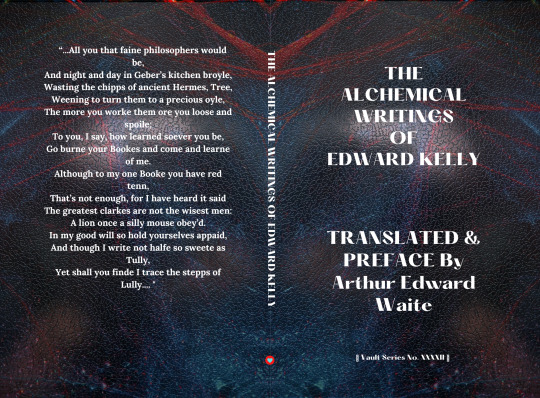
"The Alchemical Writings of Edward Kelly" invites readers into the mystical realm of alchemy through the eyes and pen of the enigmatic Edward Kelly, a figure deeply intertwined with the alchemical pursuits of the Renaissance. This collection, skillfully compiled and annotated, unveils the arcane wisdom and esoteric insights of a man whose contributions to the Hermetic arts have long been shrouded in mystery.
Kelly's writings, presented with meticulous attention to historical context, offer a profound glimpse into the spiritual and transformative aspects of alchemy. The editor's annotations guide readers through the labyrinth of alchemical symbolism, providing clarity without diminishing the mystique. From the famed Enochian system to the allegorical language of transmutation, Kelly's words resonate with seekers of hidden truths.
The anthology captures Kelly's alchemical opus, showcasing the intricacies of his experiments, the symbolism embedded in his writings, and the quest for spiritual enlightenment. It serves as a key to decoding the cryptic language of alchemy, making it accessible to both seasoned practitioners and curious minds.

(The illustration presented in the book: a black rock, on which stand, hand in hand, the planets: 1, Black Saturn, falling down; 2, Jupiter; 3, Mars; 4, Mercury of many colours; 5, Venus, with green robe, and the Sun and Moon. Lower down, on the black rock, stands an old man with a pick-axe, cutting a piece out of the rock, whence Saturn falls, and near him lie, as if dead, Jupiter and Saturn.)
As the pages unfold, readers are immersed in the alchemical laboratory of Kelly's mind. The author's profound understanding of the mystical journey, coupled with his ability to articulate complex concepts, makes this collection a valuable resource for those exploring the intersections of spirituality, philosophy, and the arcane sciences.
In conclusion, "The Alchemical Writings of Edward Kelly" is a captivating odyssey into the depths of alchemical thought. Whether you are a seasoned alchemist or a curious soul embarking on the quest for inner transformation, this anthology is a beacon of enlightenment. Prepare to be entranced by Kelly's alchemical tapestry—a rich weave of symbols, insights, and secrets that beckon the daring to unlock the mysteries of the alchemical tradition.
"The Alchemical Writings of Edward Kelly" is available in Amazon in paperback 12.99$ and hardcover 18.99$ editions.
Number of pages: 143
Language: English
Rating: 10/10
Link of the book!
Review By: King's Cat
#Edward Kelly#Alchemical writings#Hermetic wisdom#Enochian system#Renaissance alchemy#Mystical transformation#Esoteric symbolism#Spiritual enlightenment#Alchemical experiments#Transmutation allegories#Hidden truths#Cryptic language#Alchemical opus#Inner transformation#Arcane sciences#Alchemical philosophy#Spiritual journey#Elixir of life#Occult symbolism#Mystic insights
1 note
·
View note
Text
Magnum Opus or Great Work: Alchemical Codes in "Harry Potter"
"I've never wanted to be a witch, but an alchemist, now that's a different matter. To invent this wizard world, I've learned a ridiculous amount about alchemy." JKR. By the way, it seems JKR never became an alchemist because you can't be that evil an alchemist, Joanne. Something went wrong.
The first part about Lily and James
Voldemort – an occult alchemist, Lucifer. Snape – a Seeker who chose the wrong Path. Dumbledore – Keeper of the Tower. Hermione – Hermes Trismegistus. Harry, Hermione and Ron – the three principles for creating the Philosopher's Stone.
Alchemy is the universal path of spiritual transformation. In a literal sense, universal, this code is practically everywhere–from ancient myths and the Bible to the philosophy of Nietzsche (though in his understanding) and Jung's books. Harry Potter himself is a complete alchemist's path, but there's also a well-displayed second path–the path of the occult alchemist.
True alchemy tells us that God is in everything, like a seed present in every person. Through alchemical transformation, a person can be reborn – and become golden, divine, immortal.
Many famous people were fascinated by these ideas – from Newton to Goethe, from Walter to Mozart. Yes, Walter and Mozart were freemasons, but freemasonry is built on the Magnum Opus, it's its foundation. Who has seen the opera The Magic Flute? A completely masonic opera: the surface layer was for the people, and the deeper layer – for the spiritual elite of that time. In this opera, the power of love transforms people and makes them divine. Oh, it seems to resemble Harry Potter, hehe... Harry Potter also has two layers – one as a fairytale about a wizard for teenagers, the other – for those who can "feel" the symbols, even without knowing them.
Each symbol can be interpreted in several ways, that's the complexity of alchemical symbolism. For example, Albus Dumbledore. He symbolizes (in JKR's own words) Spirit ( he's white), and Rubeus Hagrid – Soul (red) – and they're both like two fatherly figures for Harry, distant and warm, judicious and understanding. But all this is at the character level. Dumbledore has other meanings – much more important ones. As I've said before, the symbolic level and the character level are different levels. In interpreting symbols, you don't need to interpret every line, you need to take the context as a whole. Characters operate on one level, symbols – on another.
So, alchemy is an extension of the universal idea – to be reborn, you need to "die." Like Jesus died on the cross, Orpheus on the banks of the River Gebre, and Osiris in the coffin prepared by Typhon, in alchemy, until all the elements (parts of the old personality) die, the work cannot be completed.
The stages of this alchemical process can be traced in the lives of almost all world "heroes" and in the mythology and legends of many cultures. This is a universal code.
“Very truly I tell you, no one can see the kingdom of God unless they are born again” John 3:3
Alchemy proclaims that without decomposition, the Great Work cannot be accomplished.
The past Self dies on the cross and in the retorts and becomes black during decomposition. The new Self rises from hell, like a phoenix. The phoenix is a pure alchemical symbol.

This is the creation of the Philosopher's Stone.
It is symbolically described in "The Chymical Wedding of Christian Rosenkreutz". The book presents an allegorical story divided into "Seven Days" or "Seven Journeys," which tells how its author, Christian Rosenkreutz, was invited to a castle full of wonders to help with the "Chymical Wedding" of the king and queen. Harry also receives a letter in a storm (like Rosenkreutz) and goes to the castle for 7 years, chooses one of the four paths (Gryffindor), and so on.
Alchemists called the creation of the Philosopher's Stone the Great Work – Opus Magnum. This process consisted of three stages: decomposition (nigredo), rebirth (albedo), and final perfection (rubedo). Each of these stages corresponded to a specific colour: black, white and red.

Nigredo. Albedo. Rubedo.
In Harry Potter, these stages correspond to Sirius Black, Albus (white) Dumbledore, and Rubeus (red) Hagrid. The end of each stage is marked by their death. In the seventh book, it's Hagrid who carries the "dead" Harry.
There is a fundamental difference between "true alchemists" and "occult alchemist."
Tom Riddle is an occult alchemist. For him, the Great Work is also self-creation, but what kind? For him, it is complete mastery of his abilities and his future, and especially the complete liberation of his will.
Tom is a will, but his will not submissive to the will of God. It's a Luciferian will. The will of a fallen angel who began to oppose his own free will to the influence of Divine Love-Light. Instead, he sought and loved his own power outside Divinity, in himself.
"Better to reign in Hell, than serve in Heaven" John Milton, "Paradise Lost"
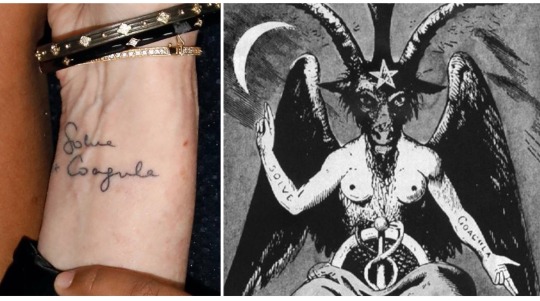
Baphomet, or the Sabbatic Goat, drawing by Eliphas Levi, on its hands are inscriptions "Solve et Coagula." This is an alchemical principle. JKR, by the way, also has such a tattoo.
In occultism, it is believed that magic is control of one's will, and a will can control matter. After all, what did his followers choose for their motto? Magic is Might. Harry never defeated Voldemort with such magic. Because he doesn't need it.
What does Tom boast about? Tom boasts that he has mastered the deepest depths of dark magic. He went so far in it as no one before. Dark magic requires an iron will, and Tom achieved incredible heights in it. He even achieved immortality in this material universe, literally cursing his soul! Only Tom doesn't understand that Dumbledore (a true alchemist) is not interested in all this. Because true immortality is not there. True transformation is not there. Because their paths are completely different – Dumbledore is going to the "God and divine immortality," and Tom is going to "material immortality."
In general, fans of occult alchemy, the Left-Hand Path, and Nietzschean philosophy probably consider Tom a much more interesting character because here he is – the king of matter, a man of incredible will and strength who destroys the slave Christian morality and proclaims that God is dead, long live the Übermensch (homo superior)! (Nietzsche would have been proud of him…) By the way, Bellatrix is most likely symbolically – Lilith, Adam's first wife according to Kabbalistic apocrypha, who rebelled against Adam. God created them equal, and Adam wanted to have power over Lilith... In short, Lilith is the first feminist in human history, hehe.
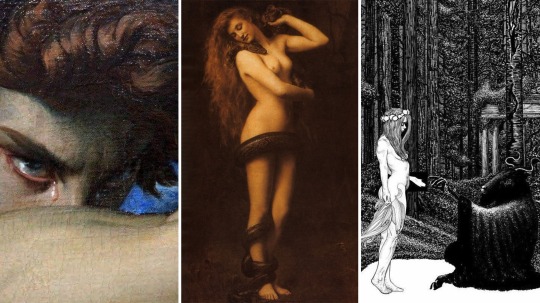
The Fallen Angel by Alexandre Cabanel. Lilith.
In short, Tom Riddle is such an adept of broken alchemy. Where Tom is his own personal will, Harry is Faith and the will of the Spirit. Harry is also very strong-willed, but his will is different, it's not individualistic. It's a will of sacrifice, a will of love, a will of mercy, a will of trust. The main theme of the seventh book is a crisis of faith. And what kind of will does one need to show to continue the quest for Horcruxes and not go for the Deathly Hallows? Simply put, the will of Harry and Tom is completely different.
And Tom will never understand this. He's an individualist. He's a Nietzschean Übermensch. He's reached the limits of human capabilities. But for what? From dust you are and to dust you shall return, Tom...
Severus Snape — a Seaker who chose the wrong Path
And Snape, by the way, initially turns away from Lily (Lily is love of God, represented in the world). Because he's obsessed with becoming dark magic, his ego and desire for secret knowledge and being proud are very great.
Btw, Lily is a mudblood. In the sense that God is not in shining beautiful armor. This is Lucifer's mask – to be pure, to shine, to sparkle. But the real God can be found by seeking, under the feet of the poorest and "dirtiest" person. After all, for God, everyone is equal. It's the Devil who divides.
And pure-bloods, for example, the Blacks, are "false purity." Luciferian purity. Material purity, purity of shining gold. It's division. And where there's division – there's the Devil.
In short, Snape turns away from Lily because this path is difficult, he doesn't understand how to approach her, he already uses dark magic, has a lot of knowledge, and delves into various secrets, and shows what "bad" paths other seekers (the Marauders) take... (The seeker is not my term, it's from the Rosicrucian manifesto, alchemists call themselves seekers) But Lily still refuses to unite Spirit and Soul. And he calls her a "mudblood," insulting her. For Lily, this is a sign that this soul is almost lost. And there's no sincere regret in him when he asks for forgiveness. He asks her to forgive him, but his soul is still on the old Path. Lily isn't angry with him, it's not about anger or offense. Snape's soul is almost lost at this moment, closed to the divine spark and love. After all, for love to enter your heart, you first need to open yourself to it.
Only when Snape sees true face of Tom's "alchemy," in which Tom is ready to kill Love, the divine spark, essentially kill God in the souls of all people, then Snape, as a real Seeker, realizes that he's going the wrong way... And he runs to the main Alchemist, Dumbledore, to ask to preserve this love, this manifestation of God on earth.
But you can't preserve it without preserving the seeker of the right Path in your soul (James) and without preserving the possibility of the emergence of the transformed soul (Harry).
This is a very important moment, not only because you can't kill people in principle. Dumbledore literally tells him that you can't save love of God, the divine spark in your soul, if you kill in yourself the one who reaches out to God (the deer) and if you kill the POSSIBILITY of becoming this new transformed soul (Harry).
For Snape, this becomes a turning point, and he decides to switch sides to true alchemy. Dumbledore asks in return for Snape's soul, but not in the sense that the Devil demands it, he asks for loyalty to the Path. Below I'll explain the symbolism of Dumbledore and what he means in terms of alchemical symbolism (I don’t think he is God).
Snape becomes loyal to Dumbledore. But Lily is killed, as is James. The world, despite the fact that Voldemort temporarily goes into hibernation (and the Savior is alive), plunges into despair. Sirius (as a divine symbol of light) is in captivity, Remus (a symbol of a seeker with a "good but not brave" soul) is somewhere wandering the world, and Harry lives very poorly with the Dursleys... Harry doesn't know any God, and the seeker in him is also "dead". And Voldemort will soon rise again, he's just gathering strength.
Harry's path is the path of returning to God through Mother of God (Theotokos). Because it is Mother of God who is the true Spirit. That's why he meets Lily only at the end of the seventh book, when he's almost completed the alchemical transformation. For Christians, this is heresy, but for alchemists, it's not. The Son and Mother of God are one whole. The Virgin Mary is part of the Trinity, because only through the spiritual unity of the Mother and the Son is the salvation of humanity possible.
And who does he meet her through? Through Snape. Who dedicated his entire life to transforming his Soul, merging it with the Spirit, ultimately coming to God.
He spent his whole life hating James, as a Seeker of a different kind, not like him—Snape always leaned a bit towards Nietzschean stories. And James always hated Dark Magic and all dark things (although this doesn't make the souls of this type much better, they can also be egocentric). Snape teaches Potions, he knows how to bottle up Love, Death and Luck... So much power, so much pride in this...
Recently, I reposted a very interesting post. Snape wanted to recover his soul, because he was guilty of Lily's death. A very beautiful meta, but I see a bit different alchemical meaning. His soul is broken not only because Lily partly died because of him. His soul is broken overall because of the Path he chose - that of an occult alchemist, and he remains a "spy" to the end of his days, playing two roles, constantly "here and there". He dies at the hands of his former master.
Snape takes Lily's letter because he needs Lily's love (like people wear crosses), while there isn't enough understanding of where to go (Dumbledore is already dead)
Snape always yearned for Lily. And Dumbledore asks for us, the readers: "After all this time?" And Snape answers for us "Always." You must love God always. And that is salvation for the soul.

In general, Snape only understands towards the end that you cannot love Lily without Harry and even James. Only one Path leads to Lily - the same as James’s path. The path of Ego, pride, thirst for power, secret knowledge, occultism, malice, hatred must finally dissolve. Snape fully exposes himself to Harry, although he shouldn't have (he should only pass on information about death), revealing the good (and the bad) that he always hid. His revelation to him speaks of his complete acceptance. He shows him his soul, literally bowing his head to him - here I am, here is my soul, in some things I have no excuse, sometimes I have justification, but I've been seeking God, seeking love all my life.
Will you accept my wounded soul?
This is confession. The realest confession.
And Harry accepts. Of course, Harry accepts. He looks at him with Lily's eyes.
Because no matter how "bad" you are, if you truly love God in your soul, if you truly seek Him, there will always be a place for you in the City of God. Snape is the constantly replayed plot of the Prodigal Son's return.
At this moment, all the "black" in Snape dies – the nigredo. Tears - the white stage, purification – the albedo stage, purification. Blood – naturally, the red stage. The alchemical transformation for Snape is complete.
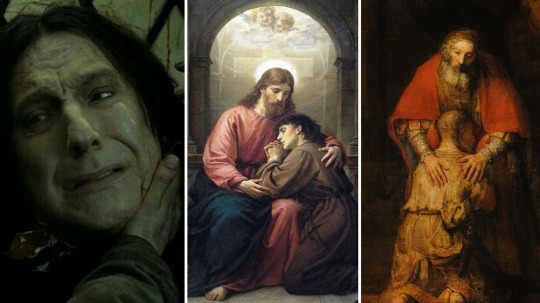
(But geniuses from TikTok will still say that Harry shouldn't have named his son Albus Severus, because Snape was baaaad. Ofc he was bad sometimes, that's the point!)
Dumbledore is the embodied Path and Plan
As I mentioned before, Dumbledore asks for Snape's soul in return, but not in the sense that the Devil demands it, he asks for loyalty to the alchemical Path.
Dumbledore, as an alchemist, besides embodying the completion of the albedo stage for Harry with his death, is also the embodied Path. Dumbledore is the highest Guardian of the Tower, who watches over the Paths of others, he is the Man of Spirit, he is the Principle, he is the Master. What is the difference between Dumbledore and Lily? Lily is a more important symbol, she is like pure divine power, God = love, as in what all souls dissolve. Dumbledore, on the other hand, is the Guardian of the Path through which everyone must pass. In short, Lily is the answer to the question "where", and Dumbledore is the "how". And Dumbledore is just a man who also underwent his alchemical transformation and who can also succumb to temptation. But Dumbledore is not GOD, imo. To personify God in a book is too much (even for me, although I’m not religious at all). I don’t like the idea of him being God and... really, where? God is transcendent and pure divine love emanates from Lily that’s why she almost an empty canvas. Dumbledore is a principle. He is the answer to the question "HOW". That's why he asks to believe in him, believe in the ALCHEMICAL PATH AND PLAN. FOLLOW THIS PLAN TO THE END. Ascend the tower, as I once ascended it. After all, he lives up there in the tower. He observes.
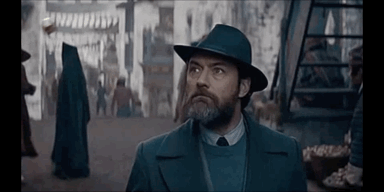
For Snape, Dumbledore is so important because Dumbledore is the Path, a new Path that he did not have. And Dumbledore's death is so important for everyone because now no one points them towards the Path. But they must find this Path within themselves. Because the answers are inside them. You cannot become a true Alchemist if you constantly rely on external help. It's time to see the Path independently.
"You must kill me."
There was a long silence, broken only by an odd clicking noise. Fawkes the phoenix was gnawing a bit of cuttlebone. (HP and DH)
After Dumbledore says that Snape must kill him, there is silence and a very clear symbol - the phoenix and the bone. It's time for their souls to go independently, to eat away all the old to come to rebirth. Meanwhile, they also need to save Draco, who, by "Lucifer's" order, is about to kill the Path (although you can't outplay God's plan...). And then Dumbledore reveals that Harry must die.
This shocks Snape. Like any alchemist on the Path. How so, to die? After all, we all do everything to become closer to God, to immortality, and you say – just die? What kind of Path is this?
"I thought…all these years…that we were protecting him for her. For Lily.”
After all, we were protecting Harry for Lily, because as I've already said, only through the spiritual unity of the Mother and the Son is the salvation of humanity possible. Snape is protecting the son for the mother, and Dumbledore wants to kill him? For what?
Simply put, Snape doesn't understand that no one can save Harry until he dies and is reborn. It's painful, but all heroes go through this path for rebirth.
Dumbledore knows that there is a "seed" of "evil" in Harry, as in any of us. After the fall, we all carry Luciferian part within us. This is the last thing that must die in Harry, and he himself must die for it.
No one promised that the path of the alchemist would be easy. It's understandable why not everyone loves Dumbledore, he seems too cold and manipulative, but there is no other way for Harry on the symbolic level.
The Great Work
There are three stages of the Great Work: decomposition (nigredo), purification (albedo) and ultimate perfection (rubedo). These stages for Harry culminate in the deaths of Sirius Black, Albus Dumbledore, and his own death, where he is carried out of the forest by Rubeus Hagrid.

And the result of his alchemical work should be Rebis — essentially the alchemical philosopher's stone, an androgynous being. In the collection of dialogues attributed to Hermes Trismegistus, God is depicted as androgynous. (Hermes Trismegistus is essentially the one who created the corpus of Hermetic texts).
Rebis is the unity of opposites. Day and night, Man and Woman, Good and Evil, Light and Darkness. All is one. There is no division. The wholeness of God. After the fall, we are all divided. And after the alchemical transformation, we can finally become whole and find ourselves and God.
In the form of merged men and women, sometimes depicted as the Virgin Mary and Christ, because They are one whole. As I have already said, for many alchemists, the Virgin Mary is part of the Trinity because only through the spiritual unity of the Mother and the Son was the redemption of original sin made possible. As I have already said, although Harry suffers more for James (his father turned out not to be as ideal as he thought), Lily is the main symbol in "Harry Potter".

The Nigredo stage literally means "blackness" - it signifies complete breakdown, decay, descent into the underworld, the trance of grief. It's a descent into the deepest fears, disbelief, denial, loss of self, anger, aggression. And through this - a return to the prima materia. This is what happens to Harry, "The Order of the Phoenix" is a very dark and depressing book, and with Sirius's death, this stage for Harry is completed. Sirius himself also undergoes transformations, but about this in the next part. The nigredo stage, during which a person's ego dissolves, is agonizing but necessary for further development. After the "I" meets its "shadow" and disintegrates into parts, it will need to be purified and recreated.
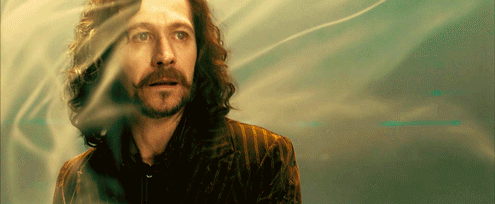
Albedo ("whiteness") symbolizes purification, transition to another world, change of life priorities, awakening, enlightenment. In alchemy, the transition from nigredo to albedo is achieved through the process of washing. The whole sixth book is misty, "white", "wet". "Washing" (albutio, baptisma) directly leads to whiteness (albedo). Purification. It's also silver, a lunar state. In Harry Potter, there is a character named Luna, which means moon in Latin. In different parts of the books, Luna also symbolizes this stage. With Dumbledore's death this stage for Harry completed.
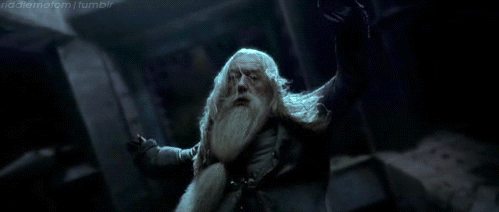
Rubedo ("redness") - the final stage of the alchemical Great Work. The alchemist must establish a kind of sacrificial relationship with his inner essence. At the final stage, the so-called "alchemical marriage" takes place: the marriage of the Red King and the White Queen - Soul and Spirit. Harry (soul) and Lily (spirit) are united. With Hagrid carrying Harry this stage for Harry completed.

Bu the way, the Golden Snitch is an alchemical symbol also.
Firstly, Harry's position is called the Seeker. Alchemists also called themselves that. Secondly, the winged disc is a very ancient symbol, meaning the sun (God) and immortality.
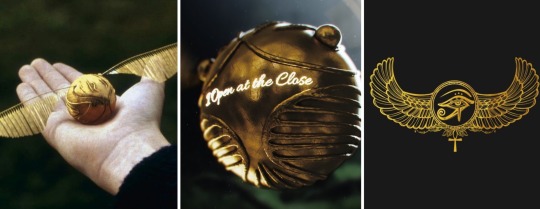
The Snitch reveals to him the Resurrection Stone, and Harry "encounters" his main symbols, but the main one is Lily. It is her he asks not to leave him.
Harry's death here is read by everyone as the well-known plot of Christ's crucifixion. The path to this death is also a reference to the agony of Jesus in the Garden of Gethsemane before the Crucifixion. After all, Harry also wanted to end up somewhere, but Hogwarts is his home, and he accepts his fate.
My Father! all things are possible for Thee: take this cup of suffering away from me: and yet not what I desire, but what Thou desirest. Mark 14:36
He wanted to be stopped, to be dragged back, to be sent back home... But he was home.

Lily's Eyes
To be honest, I can assume that her green eyes was chosen at random. But what if they weren't? Her green eyes may seem illogical, as this is the colour of the snake, the colour of Slytherin, the colour of evil. But this is the occult Luciferian snake, the erroneous snake. Originally, green also dates back to Hermes Trismegistus – the god who gave the knowledge of alchemy. The most famous of the old hermetic-alchemical texts is inscribed on the "Emerald Tablet". According to legend, this document was left by Hermes Trismegistus on a plate of emerald in an Egyptian temple.
"The Emerald Tablet" is very important for alchemists." According to legend, a large emerald fell to the earth from Lucifer's head when he was cast out of heaven. From the same emerald that fell from the crown of the fallen Lucifer, angels made the Holy Grail (which is also the philosopher's stone, and the Snitch...). Emerald is a sacred green stone, and the heavenly divine world - the homeland of the emerald - a precious stone in which information about the heavenly homeland is encoded.
There is also the Ouroboros - a snake that devours its own tail - a symbol of infinity and immortality.
And the Snitch, which is a reflection of Hermes Trismegistus' staff (which has two battling snakes - two opposites, Spirit and Soul, Good and Evil and so on, and Hermes establishes unity between them with his staff).

Occultists, of course, interpret these symbols in their own way.
Hermione is Hermes Trismegistus. Mercury. Ron — Sulphur. Harry— Salt.
Hermione (Ἑρμιόνη [hermi. ónɛː]) is a feminine given name derived from the Greek messenger god Hermes. As I said, Hermes Trismegistus is the main figure of Hermetic teaching, he is also the one who predicted the coming of the Savior (traditional Christianity should not be confused with Gnostic teachings, the Church has always been against Gnosticism). In addition, Hermes is Mercury, and that is knowledge. Hermes Trismegistus shares "secret knowledge" with the world, which forms the basis of many Gnostic directions - from alchemy to Kabbalah.
Hermione is a little alchemist, she shares knowledge. It is Hermione who insists on complete trust in Dumbledore, it is Hermione who often leads Harry in the right direction when Dumbledore is not around. It is through Dumbledore and Hermione that "moral lessons" are often sounded, which often seem completely out of place. Like when Dumbledore says that James would forgive Peter. At that moment, I always want to say, "Are you out of your mind?!" although I understand that it is described on a symbolic, not personal level.

Mercury (Hermione), Sulphur (Ron), and Salt (Harry) were necessary in the alchemical transformation and were the main components. To create the philosopher's stone, all three elements had to be combined, and Harry is next to them throughout all the books.
Both Hermione and Ron are equally important in Harry's development.

Mercury is the more fluid primary principle, more rational, the feminine principle, while Sulphur is dynamic, expansive, unstable, acidic, unifying, masculine, paternal, and fiery principle. Sulphur is emotional, it is desire and passionate impulse that motivates life. Sulphur is desire. And according to Jung's reflections, it can also be foul and dangerous. Complete transmutation depends on the correct application of this variable principle. Sulphur must be of quality for transmutation to occur. And Ron achieves this quality.
Also, in mystical alchemy, Sulphur is crystallized inspiration of Mercury (Mercury).
Mercury and Sulphur are simultaneously antagonists, like the male and female elements, but at the same time Sulphur is crystallized Mercury.
So I have always been and will always be for Romione! Hehe. They were made for each other!
And as for Salt - that's Harry. It's the body. Sometimes it is called earth and body, salt is the essential body (corpus).
Alchemists say that salt was the first substance created by fire, emanating from God. In salt, all creation is concentrated, in salt the beginning and the end of all things.
Salt is associated with the ultimate elevation of matter - with matter that has acquired consciousness, achieved through the unity of opposites, including the unity of fire and water, the unity of what is above and what is below. Salt is the ultimate Philosopher's Stone, representing transcendence and ultimate knowledge.
Thus, salt symbolizes consciousness (thoughts, feelings, material, etc.), which must be elevated through alchemical processes of dissolution and recrystallization. Well, that's Harry himself.

Just love this stupid moment
Well, that's it, I think I've said everything, and from the next part, we can move on to the Marauders themselves :D
#i'm wondering if anyone but me is even interested in this at all#harry potter meta#harry potter#hermione granger#ron weasley#pro ron weasley#rubeus hagrid#pro severus snape#pro albus dumbledore#pro romione#hp meta#severus snape meta#lily evans#tom riddle#voldemort#tom riddle meta#bellatrix lestrange
46 notes
·
View notes
Text
About Imunlaukr, the hero from the Blizzard Strayer artifact set again.
From the Sacrificial Greatsword description:
"In the eyes of the Imunlaukr clan, combat existed not for protection, for glory, or for gaining territory. Rather, it was for the amusement of the gods, high up in the heavens, for whom little else could serve to entertain."
It kiiind of fits the philosophy that Childe describes. And for some reason Imunlaukr's story is found in artifacts from the same domain as Parsifal's story (although one could argue that both are just relevant for Old Mondstadt and leave it at that. a clan founded by an outsider and someone who left their clan and became an outsider).
The description of Starsilver Claymore belonging to Imunlaukr suggests it was a philosophy born of despair, but then people lie about their motives, and legends embellish things, and the sword itself is found in the tomb with these murals:

The murals have been analyzed to pieces by now. Something something forbidden knowledge.
It's all connected somehow but I can't understand.
I still think that The Boar Princess tells the story of Imunlaukr and how he came to Sal Vindagnyr. I think he brought something that resulted in Celestia nailing the place. The story then has been erased from Irminsul and all that we have now is a pathetic fairytale book with some vague hints.
Also. Childe's shoulder ornament resembles the one angelic dude wears, Childe's scarf ornament resembles the alchemical symbol for antimony (associated with wolves and the penultimate step to purifying gold. idk, western esotericism is weird), the description of the Boar Princess wolf's mental state change sounds uncannily similar to Childe.
Also the squirrel from the tale. "Of all the beings in the ancient world, none were more evil than Woobakwa — not even demons and dragons." ("extremely evil technique" repeatedly encountered in CN names of Childe's skills and constellations), and Surtalogi being called "Extremely evil knight" (极恶骑) in Chinese.
You know, I think there are enough parallels to assume at least the same samsara if not the same martial art with the same teacher. I think Surtalogi or someone who taught him had a hand in whatever happened to Sal Vindagnyr.
(and also whatever technique Childe wields, it has a potential to get a place nailed)
Sal Vindagnyr destruction also predates Khaenri'ah and the Cataclysm by five hundred years, so either this guy was not initially Khaenri'ahn (and, by association, maybe neither was Gold), or we have to brace ourselves for levels of powerscaling previously unknown to science.
#genshin lore tumour#dragonspine#if abyss be thy name I pledge to you my loyalty#childe#tartaglia#surtalogi#rhinedottir
36 notes
·
View notes
Text
The Quintessence | The Fifth Element in Alchemy
The four classical elements, Earth, Water, Air, and Fire, were believed to make up everything in the physical world. However, alchemists believed that there must be another element beyond these four, an element that would be the key to understanding the secrets of the universe.
The quintessence, also known as aether, was the fifth element that alchemists believed existed. It was believed to be a…
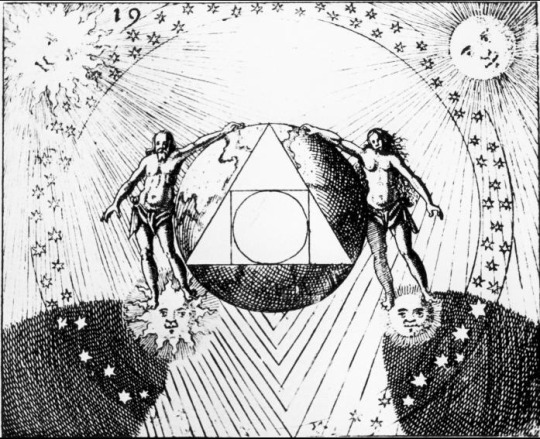
View On WordPress
#aether#alchemical#alchemy#ancient Greece#Ancient Greek philosophy#celestial bodies#creation#dark energy#elemental#ether#fifth element#healing#matter#philosophy#quintessence#quintessential#spirit#spiritual transformation#the fifth element#the universe#transformation#transmutation
4 notes
·
View notes